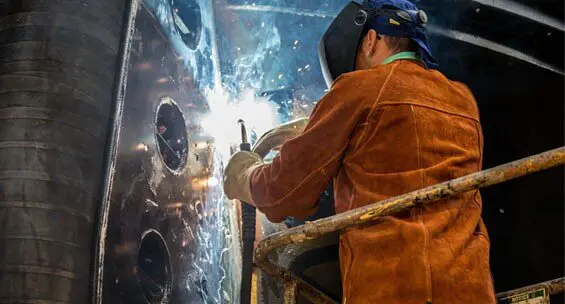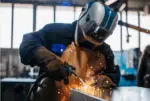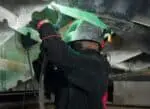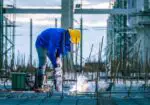When it comes to welding, there are several important factors to consider. You’re not simply melting metal with heat as there are sparks that are continually flying around you that are dangerous.
Because experienced welders are exposed to fumes, heat, and sparks, an all-around welding jacket is required, especially leather welding jackets.
That is because leather welding jackets are made to be heat resistant. They’re composed of high-quality leather with abrasion and electrical resistance that protects your skin from hot spatter and burns.
This means it is an unequalled piece of personal protective equipment that protects the shoulders, arms, torso, neck, and back.
Features of a Good Welding Jacket
1.) Quality
You won’t pay a low price for the greatest quality jacket, because high-quality leather is a durable material, but without strong stitching, it will not be able to protect you better. Jackets stitched with Kevlar thread often outlive ordinary sewed jackets.
Cotton and mixed material jackets are normally lower-quality materials for welding jackets, nevertheless, if well-made, they may survive for a long time.
2.) Heat and splatter resistance
If you’re performing welding that creates a lot of spatter, like stick welding, get a leather jacket as it will not let the hot spatter penetrate through it and burn your skin.
If it’s summer, if you’re concerned about the weight and feel of a leather jacket, a flame-resistant cotton coat or a combination of the two can work just as well. It will never protect you as much as if it had vast areas of cotton, but it will suffice.
3.) Feel
The interior lining, the design of the cuffs and collars, and the style of the jacket’s cut all influence how it feels. Depending on the brand, there are several jackets available.
Others have a more durable substance, but they adapt to your figure with time. There are other jackets with internal linings that are still leather but have a softer and more pleasant satin inside lining to put on and remove.
Whatever you like, each jacket has a distinct feel, which is crucial to consider, as you need to ensure your comfort while working.
4.) Weight
The weight of a jacket varies based on the material. While leather welding jackets provide superior protection, they are somewhat heavier, which some people dislike.
A cotton jacket, especially one made of cotton and leather, will provide some protection without requiring you to wear a heavy one.
Benefits of leather jackets while welding
1.) Leather jackets are robust.
Leather is known for its strong nature, which means it is going to protect you strongly against sparks and spatter. It will not let the spark penetrate its surface and reach your skin.
This is a huge relief when it comes to welding work because a lot of heat is utilised to melt and bind metals, and you need to ensure that you are safe.
2.) Leather has a long useful life.
When it comes to welding jackets, leather is the most durable material and is well recognised for its features such as thermal resistance and fire resistance.
We recommend leather jackets for welding since you’ll be sorted for a long time if you get a quality leather jacket.
3.) Cut and abrasion resistant.
Leather is a tough material that is inherently abrasion resistant and protects against accidental contact with fire and sparks which makes it an apt material for welding.
4.) Leather provides good electrical resistance.
Leather jackets, to a certain extent, tend to block the flow of electricity if ever you’re in danger of being electrocuted, and that is why they are used in the manufacturing of welding gloves also.
5.) Heat and fire resistant.
Extensive research has shown that leather beats other materials in terms of flame resistance, such as textiles or synthetics, as it can withstand short-term temperatures of up to 200°C.
6.) Good protection factor.
It is true that out of all the natural fabrics available, leather is the most strong, durable and reliable material that will keep you safe against all welding hazards, and a leather welding jacket will protect the upper part of your body while you are working with heat.
And that is why, leather isn’t just used in the production of welding jackets, they are also used to make protective gloves, aprons and even boots for jobs that require safety.
Can you use regular jackets while welding?
Absolutely not. It is not at all advised to use any other regular jackets for welding as it might not be safe for you. There are considerable differences between a regular jacket and a welding jacket.
Let us have a look at it. Welding jackets differ from normal jackets in the following ways:
1.) Regular jackets have their pockets either taped shut or flap folded over them to prevent metal sparks from entering and burning through to your flesh.
2.) To avoid electrocution, they feature a high electrical resistance, which you might not find in any regular jacket.
3.) Welding jackets are constructed of fire-retardant material and contain thermal insulation to prevent your skin from being damaged by the tremendous heat created by the welding arc’s infrared radiation.
Are there any other materials used for welding jackets apart from leather?
1.) Flame retardant fabrics.
Regular fabrics that have been treated with a particular flame-retardant coating are known as fire-retardant fabrics. They will burn, but more slowly than conventional untreated fabrics.
FR fabrics are available in a range of materials on the market: FR cotton, FR cotton-nylon mixes, sateen, and proprietary materials such as ‘Nomex,’ ‘WeldX,’ or ‘Weldas.’
Pros and cons of FR fabrics-
| Pros | Cons |
| FR fabric welding jackets are lightweight and do not restrict arm movement.
They are long-lasting and are heat, cut, and electrically resistant. |
Unless treated with Indura®, the fire-retardant chemical goes out after frequent washes.
They cannot endure high temperatures. They are not suitable for heavy-duty welding because strong sparks and splatter might burn holes in the cloth. |
2.) Nylon/Kevlar blend
Nylon is a lightweight, stretchy, and robust synthetic fabric. Kevlar is a strong, heat-resistant synthetic fabric. And the combination of the two results in a fine substance that is mostly used to prevent skin burns.
It is appropriate for all industrial and heavy-duty welding work since it is breathable and very flexible, making it an excellent choice for individuals who operate in hot regions.
But nothing beats leather and its features when it comes to protecting you against welding hazards.
Therefore, here are some recommended leather welding jackets.
1.) QeeLink Leather Welding Jacket
- SUPERIOR PROTECTION
- MORE DURABLE
- 4 TOOL POCKETS
- ADJUSTABLE NECK, CUFFS and WAIST
- MULTI - FUNCT
Prices pulled from the Amazon Product Advertising API on:
Product prices and availability are accurate as of the date/time indicated and are subject to change. Any price and availability information displayed on [relevant Amazon Site(s), as applicable] at the time of purchase will apply to the purchase of this product.
We feel that the QeeLink Leather Welding Jacket is the best one on the market. It can get hot while welding outside in the sun, but it provides the finest protection for all types of welding.
It’s composed of split cowhide leather and is totally stitched with strong Kevlar thread, so no seams come undone and no joints are pierced by welding heat and spatter.
2.) Black Stallion Leather Welding Jacket
- Standup welders collar with two snap options
- Satin-lined shoulders make it easier to put on and take off and an adjustable waist snaps provide a better fit
- Scribe pocket on left sleeve and inside pocket protects small tools and other gear
- Gusseted underarms allow wider range of movem
Prices pulled from the Amazon Product Advertising API on:
Product prices and availability are accurate as of the date/time indicated and are subject to change. Any price and availability information displayed on [relevant Amazon Site(s), as applicable] at the time of purchase will apply to the purchase of this product.
The Black Stallion jacket is a heavy-duty leather jacket that is reasonably priced. It’s likewise constructed completely of split cowhide leather.
Its shoulders are inside lined with satin, making it simple to put on and take off. When heavy spatter sends searing blobs of metal at your neck, the adjustable collar provides the necessary protection.
3.) Lincoln Electric Heavy Duty Leather Welding Jacket
- FULL LEATHER FRONT & SIDES
- ERGONOMIC LEATHER SLEEVES
- BREATHABLE FR BACK
- SPATTER GUARD BUTTON LINER
- LEATHER NECK PROTECTION
- ADJUSTABLE CUFFS
- INTERNAL STOR
Prices pulled from the Amazon Product Advertising API on:
Product prices and availability are accurate as of the date/time indicated and are subject to change. Any price and availability information displayed on [relevant Amazon Site(s), as applicable] at the time of purchase will apply to the purchase of this product.
The Lincoln Electric leather welding jacket is a well-designed jacket that performs admirably in the professional welding environment. Full coverage split cowhide leather covers the front, arms, and sides.
The backside is made of flame-retardant cotton, which allows for better comfort and heat reduction.
4.) IRONCAT Leather Welding Jacket
- Welding Apparel
- Design
- Durable Stitch
- Comfort
Prices pulled from the Amazon Product Advertising API on:
Product prices and availability are accurate as of the date/time indicated and are subject to change. Any price and availability information displayed on [relevant Amazon Site(s), as applicable] at the time of purchase will apply to the purchase of this product.
It is a tough Heat Resistant welding jacket with Kevlar stitching for heat and wear resistance, reinforced with metal rivets at stress spots. Even in the high-stress professional welding environment, this jacket should endure a long time.
Conclusion
There are several types of welding jackets to select from, but as discussed above, nothing can beat leather when it comes to reliability in the welding protection.
We have given you enough evidence on why and how leather is better than any other fabric available. Hope this article helps.












